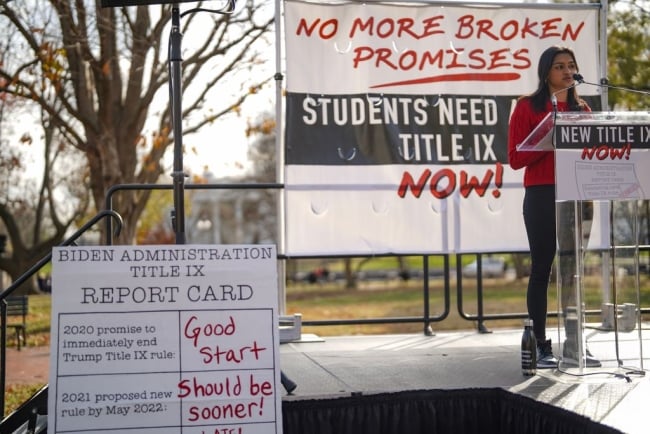You have /5 articles left.
Sign up for a free account or log in.

The long-awaited Title IX rules are out, months later than what the Biden administration initially said.
Photo by Leigh Vogel/Getty Images for National Women's Law Center
After several delays, the Biden administration finally released its final rule overhauling Title IX this morning, kicking off what will likely be a frantic few months as colleges race to update their policies in time for the coming academic year. Colleges and universities have until Aug. 1 to comply.
Title IX of the Education Amendments of 1972 protects students in all levels of education from sex-based discrimination. The new regulations, which appear similar to what was proposed in June 2022, significantly alter how colleges and universities respond to reports of sexual harassment and assault and expand protections for LGBTQ+ and pregnant students.
Other changes make it easier for victims to report sexual harassment and end the current requirement that colleges hold live hearings with an opportunity for cross-examination to allow those accused to confront their accusers. The 1,577-page regulations released Friday are here.
These new measures will strengthen vital protections for students, White House and Education Department officials said at a news conference Thursday evening. The final regulations will apply to complaints of sex discrimination regarding alleged conduct that occurs on or after Aug. 1.
“For more than 50 years, Title IX has promised an equal opportunity to learn and thrive in our nation’s schools free from sex discrimination,” Education Secretary Miguel Cardona said in a statement. “These final regulations build on the legacy of Title IX by clarifying that all our nation’s students can access schools that are safe, welcoming and respect their rights.”
The final regulations will usher in a new era for Title IX, an area of civil rights law that has become politicized and the subject of significant changes that ebb and flow depending on which administration is in charge. Colleges and universities are hoping that this latest rule will put an end to the back and forth that’s marked the last decade.
“It’s our fervent hope that this won’t change again in four years,” said S. Daniel Carter, the president of Safety Advisors for Educational (SAFE) Campuses who consults with universities on campus safety.
Carter added that he asked the Education Department’s Office for Civil Rights, which wrote the new regulations, to “issue a rule that can stand the test of time.” Whether that’s the case with this new rule, he said, will depend on how it balances the interests of those who file Title IX complaints, the parties accused of misconduct, and the college and university administrators required to adjudicate the complaints.
This set of regulations replace the Trump-era Title IX rule issued in May 2020, which overturned a swath of guidance issued during the Obama administration that was aimed in part at forcing colleges to respond more promptly to reports of sexual misconduct.
Gender justice and survivor advocacy groups, survivors of sexual assault, Democrats and others spent years criticizing the current rules, saying they are difficult to navigate and created barriers for students who want to file a complaint or receive support from a university’s Title IX office.
Rewriting the Title IX regulations has been a priority for the Biden administration and has been in the works since spring 2021. However, the rewrite proved difficult to do quickly. The final rule was initially expected in May 2023, then pushed back to October and then delayed again until March 2024. Before issuing the final rule, Education Department officials had to review and respond to more than 230,000 comments.
“This new rule will ensure survivors no longer face retaliation from their institutions for reporting sexual harassment or live under a Title IX that privileges accused perpetrators over students who were sexually assaulted,” said Tracey Vitchers, executive director of It’s On Us, a national organization working to combat campus sexual assault. “With the updated regulations, students will have tools to hold their institutions accountable for failing to comply and violating their civil rights.” Since the rules were first proposed, critics have decried the roll-back of the Trump rules, arguing it was unnecessary and would infringe on the rights of students accused of misconduct. Republicans and other critics also took issue with the decision to expand Title IX protections to include LGBTQ+ students.
North Carolina representative Virginia Foxx, the Republican chair of the House Education and Workforce Committee, said in a statement that the Education Department has placed Title IX “on the chopping block.”
“The rule also undermines existing due process rights, placing students and institutions in legal jeopardy and again undermining the protections Title IX is intended to provide,” she said.
The White House and Education Department shared a fact sheet and news release Thursday evening ahead of the final rule’s release Friday morning. Here’s what you need to know about the key changes and what’s ahead:
New Definition of Sexual Harassment
Several key changes under the new rules will bring more types of actions and incidents under colleges’ Title IX jurisdiction. Currently, the standard for sexual harassment is that the conduct is considered “severe, pervasive, and objectively offensive,” but the Biden administration would lower the standard to “sufficiently severe or pervasive.”
Additionally, colleges and universities will be responsible for addressing conduct that’s off-campus or outside the country—both of which are outside institutions’ jurisdiction in the current rules.
The broader standard and these changes in the rules could lead to a spike in reporting of incidents, some experts have said in recent months. Some colleges have reported receiving fewer Title IX complaints from students over the last four years, though there’s no national database tracking that. Experts predict an increase in Title IX complaints once the rule takes effect, and that was echoed on the press call Thursday.
“This rule is designed to encourage reporting,” a senior administration official said.
Emma Grasso Levine, senior manager of Title IX policy and programs at Know Your IX, a survivor- and youth-led project of the nonprofit Advocates for Youth, said the new definition is a key change in the new rule and will help more students get the resources and support they need.
The current standard, she said, has put the burden on students “to prove that what they have experienced has been bad enough to warrant a response from their school.”
Expanded Protections
The new rule clarifies that the sex discrimination protected under Title IX includes discrimination based on sexual orientation and gender identity, and extends new protections to students and employees who are pregnant or parenting.
Republicans have criticized the sexual orientation and gender identity provision as a “stunning affront to the purpose of Title IX.”
“This final rule dumps kerosene on the already raging fire that is Democrats’ contemptuous culture war that aims to radically redefine sex and gender,” Foxx said in the statement.
LGBTQ and gender equality advocates have said the expanded definition is a critical protection and wanted the department to go further.
Much to the disappointment of LGBTQ advocates, the final rule doesn’t include a proposal released a year ago that would prohibit blanket bans barring transgender students from participating in the sport consistent with their gender identity. Media reports have indicated that the department isn’t planning to release the controversial rule governing Title IX in athletics until after the election this fall. A senior administration official said Thursday that the process for the athletics rule is ongoing, noting that it was released nine months after comments closed on the broader Title IX rule.
Return of the Single-Investigator Model
When colleges do investigate Title IX complaints, they’ll have more flexibility to determine the best way to approach those investigations and the adjudication process.
Currently, institutions are barred from using the so-called single investigator model in which one person investigates, adjudicates and issues any sanctions against those accused of sexual misconduct. They’re also required to allow advisers to cross-examine the complaining and responding parties along with any witnesses during a live hearing. Ending the single-investigator model and requiring cross-examination were key changes in the 2020 rules aimed at ensuring those accused of misconduct have due process rights.
But the Biden administration, which has said it’s aiming to ensure that procedures to investigate and resolve complaints are fair to all involved, will allow colleges to use the single-investigator model again and won’t require cross-examination—a move that concerns due process advocates. For sex-based harassment complaints involving a student, colleges must have a process that includes either questioning by the investigator or decision-maker during individual meetings or questioning by the decision-maker in a live hearing, according to the fact sheet.
Carter, the campus safety consultant, said the single-investigator model is “not sustainable” and “won’t stand the test of time.”
“Everyone needs someone they are accountable to,” he said.
Tyler Coward, lead counselor for government affairs at the Foundation for Individual Rights and Expression, a free speech and civil liberties advocacy organization, said in an interview earlier this week that the 2020 regulations were a “huge win” for due process rights, which are protected through live hearings and cross-examination by a student’s adviser.
“The adversarial nature where you get to cross-examine witnesses, the right to have an attorney actively be present and make opening closing statements … those sorts of things really help ensure that students aren't being railroaded,” Coward said.
The return or encouragement of the single-investigator model, he said, does not balance the rights of both parties in a Title IX process.
“There’s no balance and trust in a system where one person has all that power,” he said. “It just can’t be done.”
A senior administration official told reporters that the rule provides a fair process and protections for all involved, outlining the parties’ equal access to notice, evidence and supportive services.
“It’s detailed about what equity means at every stage for every party,” the official said.
What’s Next
Levine at Know Your IX said that while she’s thrilled that the administration has taken a step in the right direction to restore students’ civil rights, it’s up to college administrators to act quickly to implement and enforce the new regulations.
“Student survivors of sexual violence, LGBTQ+ students, and pregnant and parenting students cannot afford to suffer any longer under policies that jeopardize their right to an education,” Levine said in a statement.
Colleges and universities have a little over three months to update their policies and processes and train staff on those new systems. The work will be similar to what happened in summer 2020, albeit without a pandemic looming over institutions. To help K-12 schools and postsecondary institutions come into compliance quickly, the Education Department is sharing resources for drafting Title IX nondiscrimination policies, notices of nondiscrimination, and grievance procedures.
The new Title IX rule is likely the most significant change to an established rule in higher education, said Carter, and based on the sheer bulk of work, it will be difficult for institutions to carry out their new policies on the department’s timeline, which is similar to 2020.
“It takes decades for some of these rules to be institutionalized, and now we’re turning it around in four years,” he said. “That is not easy.”




